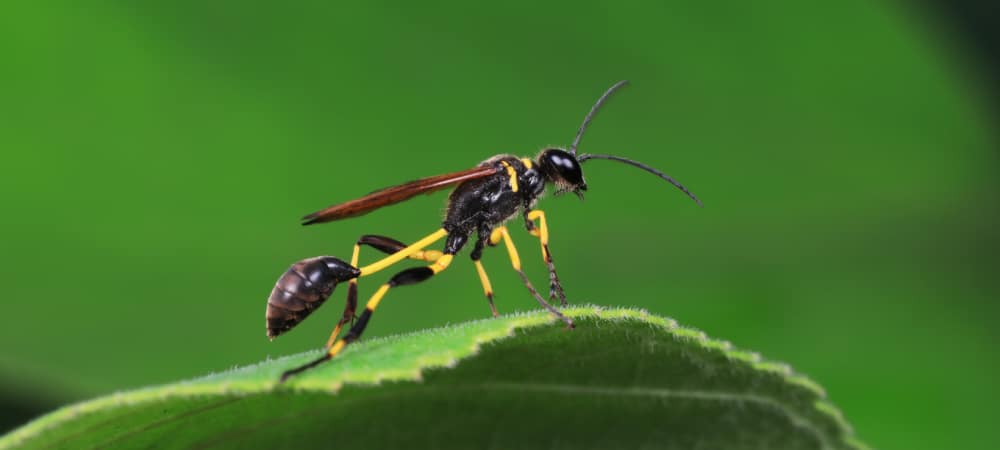
The term mud dauber refers to several species of wasps that build their nests out of mud. Mud dauber species commonly found in yards include organ pipe daubers, black-and-yellow mud daubers, and blue mud daubers. This guide will cover general mud dauber habits, how they build nests in your outdoor spaces, and how to address an infestation.
What is a mud dauber?
A mud dauber is a solitary wasp that builds its nest out of mud. They can be found across the U.S. during the spring and summer months. Because they don’t live in colonies, their habits differ from typical colonizing wasp species, including how they build homes, eat, and reproduce.
Mud dauber nests look like tunneled structures. You’ll often find them on exterior walls, roof overhangs, corners, and the undersides of decks or porches. The size of their nests vary, but they’re typically tan, brown, or gray and have a distinct, cylindrical shape.
What does a mud dauber wasp look like?
While their appearance varies from species to species, a typical adult mud dauber wasp ranges from ½ to 1 inch long. They have a thread-waisted body, meaning a long, slender segment between the thorax and abdomen. They’re usually black but occasionally have pale markings or a metallic blue shine, with clear or dark wings and legs that dangle as they fly.
What do mud dauber larvae look like?
Mud dauber larvae are typically a pale yellow and look like a standard grub with a short, round body. They live inside the mud dauber nest.The adults will traps spiders within the various tunnels it builds while creating the nest, and the larvae eat these spiders when they hatch.

Do mud daubers sting?
While they may look aggressive or intimidating, mud dauber wasps are not dangerous. They’re relatively gentle and unlikely to sting. Even when disturbed, mud daubers are not aggressive and rarely sting humans in response, although you may get stung if you attempt to handle one. If you’re stung by a mud dauber, the symptoms would be mild, resembling a typical bug bite or sting.
What attracts mud daubers?
Like most wasps, mud daubers are drawn to spaces with a source of food, water, and shelter. Mud is the primary source of material for building a mud dauber nest, so anywhere with at least one source of fresh mud is appealing. They also like an easily accessible water source, including ponds, pools, or outdoor water features. They drink the water and use it to help construct their nests. Mud daubers are also attracted to bright colors, fruits, and sweet-smelling plants. They particularly favor bright yellows and oranges.
What do mud daubers eat?
Adult mud daubers feed on plant nectar, honeydew, and fluids from the spiders they capture. Mud dauber larvae eat spiders while living in the tunnels of the adult’s nest. This process helps to reduce spider numbers and control the population of various insect species. Some species of mud daubers even feed on black widows.
How do mud daubers get in the house?
Most of the time, mud daubers won’t intentionally enter indoor spaces and prefer to make their nests and live outdoors where they can easily access their basic needs. In rare cases, some mud daubers may build a nest inside your home if they find their way inside through structural defects, including unsealed windows or doors, cracks, or windows without screens.
Are mud daubers beneficial?
Mud daubers are a vital and beneficial part of the ecosystem. Each cell of their tunnels typically holds up to 25 or 30 spiders, reducing the number of spiders in and around homes. Because a solitary mud dauber doesn’t defend its mud wasp cocoon aggressively like social wasps, they’re unlikely to harm any humans or pets, making them not only helpful but a harmless addition to your yard.
Pest control services
If you want to remove mud dauber nests from your home’s exterior, using a pest control service like Hawx Pest Control is the best way to do so safely and effectively. Using proven methods, qualified technicians, and premium products and services, Hawx is the leader in pest control solutions. Our team uses a three-fold process to address many types of pest infestations thoroughly, and we always create a custom treatment plan to meet your unique needs. Call us today for a free estimate to restore peace to your favorite outdoor spaces.
Categories
RELATED POSTS




